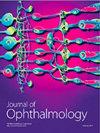Efficacy of 2% Hydroxypropyl Methylcellulose and Bandage Contact Lens for the Management of Dry Eye Disease after Cataract Surgery
IF 1.8
4区 医学
Q3 OPHTHALMOLOGY
引用次数: 0
Abstract
Objectives. To investigate the effect of 2% hydroxypropyl methylcellulose (HPMC) and bandage contact lens (BCL) on dry eye disease after cataract surgery. Methods. This prospective randomized controlled trial included 63 eyes which were divided into the balanced salt solution (BSS), HPMC, BCL, and combined HPMC and BCL (H&B) groups. The Ocular Surface Disease Index (OSDI), tear meniscus height (TMH), and average tear break-up time were measured before cataract surgery and 30 days postoperatively. Differences in corneal nerve fiber (CNF) and dendritic cell (DC) density in various directions were evaluated and compared. The CNFs and DCs in central and infratemporal directions were observed using in vivo confocal microscopy. Data were evaluated using the Kruskal–Wallis rank-sum test and analysis of variance. Results. The differences in variations in OSDI and TMH after cataract surgery between the four groups were statistically significant (). The postoperative OSDI of the HPMC group decreased compared with their preoperative OSDI. A statistically significant difference in the variations of OSDI score was observed between the HPMC and other groups (). The postoperative variations in TMH in the HPMC group were significantly higher than those observed preoperatively and significantly differed between HPMC and BCL groups and between BCL and H&B groups (). Postoperatively, the density of corneal DCs decreased in BSS and HPMC groups and increased in BCL and H&B groups (). Conclusions. The application of 2% HPMC in cataract surgery has a certain effect on managing dry eye after cataract surgery. Although the use of BCLs after cataract surgery has some benefits, it may cause mild ocular surface inflammation. Nevertheless, using 2% HPMC with BCLs in the perioperative phase of cataract surgery can alleviate the subjective discomfort of patients and can safely and effectively replace eye patch after cataract surgery.2% 羟丙基甲基纤维素和绷带式隐形眼镜治疗白内障手术后干眼症的功效
研究目的研究 2% 羟丙基甲基纤维素(HPMC)和绷带接触镜(BCL)对白内障手术后干眼症的影响。方法。这项前瞻性随机对照试验包括 63 只眼睛,分为平衡盐溶液(BSS)组、HPMC 组、BCL 组和 HPMC 与 BCL 混合组(H&B)。白内障手术前和术后30天测量了眼表疾病指数(OSDI)、泪液半月板高度(TMH)和平均泪液破裂时间。评估并比较了不同方向上角膜神经纤维(CNF)和树突状细胞(DC)密度的差异。使用体内共聚焦显微镜观察了中央和颞下方向的角膜神经纤维和树突状细胞。采用 Kruskal-Wallis 秩和检验和方差分析对数据进行评估。结果显示四组白内障术后OSDI和TMH的变化差异有统计学意义()。与术前相比,HPMC组的术后OSDI有所下降。HPMC 组与其他组的 OSDI 评分差异有统计学意义()。HPMC组术后TMH的变化明显高于术前观察到的变化,HPMC组与BCL组之间以及BCL组与H&B组之间差异显著()。术后,BSS 组和 HPMC 组角膜 DC 密度下降,BCL 组和 H&B 组角膜 DC 密度上升()。结论。在白内障手术中应用 2% HPMC 对控制白内障术后干眼症有一定效果。虽然在白内障手术后使用 BCLs 有一定的好处,但可能会引起轻微的眼表炎症。不过,在白内障手术围手术期使用 2% HPMC 和 BCLs 可以减轻患者的主观不适感,并能安全有效地替代白内障手术后的眼罩。
本文章由计算机程序翻译,如有差异,请以英文原文为准。
求助全文
约1分钟内获得全文
求助全文
来源期刊

Journal of Ophthalmology
MEDICINE, RESEARCH & EXPERIMENTAL-OPHTHALMOLOGY
CiteScore
4.30
自引率
5.30%
发文量
194
审稿时长
6-12 weeks
期刊介绍:
Journal of Ophthalmology is a peer-reviewed, Open Access journal that publishes original research articles, review articles, and clinical studies related to the anatomy, physiology and diseases of the eye. Submissions should focus on new diagnostic and surgical techniques, instrument and therapy updates, as well as clinical trials and research findings.
 求助内容:
求助内容: 应助结果提醒方式:
应助结果提醒方式:


